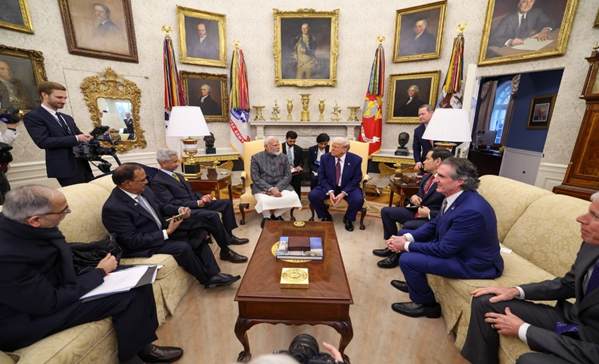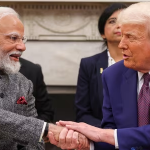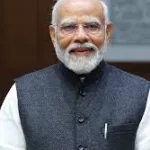The historic dialogue between Indian Prime Minister Narendra Modi and U.S. President Donald Trump on February 13, 2025, has paved the way for a revolutionary period in India-U.S. trade relations. With a vision to double bilateral trade to $500 billion by 2030, the alliance is a joint vision of “MAGA” (Make America Great Again) and “MIGA” (Make India Great Again). Together, these efforts create a “MEGA” (Mutually Empowered Growth Agreement) partnership, which represents the increased strategic and economic convergence between the two countries. This partnership is not merely about commerce—it’s about reconfiguring the international economic landscape.
A Journey Through Time: The Evolution of India-U.S. Trade
The bilateral trade ties between these two countries have evolved significantly since India’s economic liberalization also popular with the induction of India’s LPG era in 1991. From amodest 5.6billion US$in1990, the bilateral trade has been suggested to be over 180 billion US$ in 2024, marking a remarkable journey of cooperation and growth.
The majorups and downs of the bilateral trade ties can be highlighted as follows:
- 2005: U.S.-India Civil Nuclear Agreement, a defining moment that revolutionized bilateral relations.
- 2019: Trade tensions were raised with the Trump administration imposing tariff hikes, testing the strength of the alliance.
- 2023: India recovered its GSP (Generalized System of Preferences) favours, significantly augmenting exports.
- 2025: Launch of “Mission 500,” a bold new initiative to meet the $500 billion target by 2030.
- Despite occasional setbacks, both countries have been steadfast in efforts to expand economic cooperation through policy reforms, trade agreements, and strategic partnerships. This extended partnership is proof of the inherent advantages of working together.
The Current Bilateral Trade Landscape: A Snapshot
In the year 2024, the U.S. reported a US$45.7 billion trade deficit with India. India’s key exports to the U.S. include pharmaceuticals, textiles, and IT services, while the U.S. supplies India with capital goods, agricultural products, and energy resources. This trade relationship is not just about numbers—it’s about the exchange of ideas, innovation, and opportunities.
Table 1: India-U.S. Trade Statistics (2024)
| Trade Indicator | Value (USD Billion) |
| Total Bilateral Trade | 180.3 |
| U.S. Exports to India | 67.3 |
| U.S. Imports from India | 113.0 |
| Trade Deficit (U.S.) | 45.7 |
| Source: U.S. Bureau of Economic Analysis, https://www.bea.gov/index.php/news/2025/us-international-trade-goods-and-services-december-and-annual-2024 | |
Trade Agreements and Tariff Adjustments: Building Bridges
During this maiden visit of Indian PM Modi during the second tenure of the POTUS Trump during their interaction discussed the ways to address bilateral trade imbalances and foster a more equitable relationship, both leaders announced plans to negotiate a comprehensive Bilateral Trade Agreement (BTA) by late 2025.This agreement will align with WTO and UNCTAD guidelines, ensuring fair and inclusive trade policies.
Some of the key tariff adjustments include:
India’s Tariff Reductions on the U.S. Goods:
- Bourbon Whiskey: 25% → 15%
- Reduced Custom Duty on Foreign Motorcycles including Harley Davidson: 50% → 30%; the gesture was also an integral part of the recently tabled Union Budget 2025-26 in a bid to reduce trade tensions with America.
- ICT Products: 10% → 5%
Ease of Market Access for Indian Products in the USA:
- Increased quotas for Indian Fruits like Mangoes and Pomegranates.
- Easier trade facilitation for textiles and pharmaceuticals.
In the joint press conference statement made by the POTUS, it is not easy to do business in India since India possesses one of the highest tariff rates among world economies. The data shows India’s average tariff rate of 17% is still one of the highest among the big economies, as compared to 8% for China, 13% for South Korea, 11% for Brazil, and 5% for the European Union. The U.S., with a 3% average tariff rate, is advocating for deeper cuts to balance trade. These cuts are not merely about figures—they’re about establishing a fair playing field for businesses on both sides.
Table 2: Tariff Adjustments in India-U.S. Trade
| Product Category | India’s Tariff Reduction (%) | U.S. Market Access Expansion |
| Bourbon Whiskey | 25 → 15 | Increased import quotas |
| Motorcycles | 50 → 30 | No new tariffs |
| ICT Products | 10 → 5 | Increased software exports |
| Agricultural Goods | Selective reductions | Indian fruits, spices |
| Source: World Tariff Profile 2023, https://www.wto.org/english/res_e/publications_e/world_tariff_profiles23_e.htm | ||
India’s issues: A Balance to be achieved
Although market access and tariff cuts are the priorities of the USA, India also has some priorities in terms of issues:
- Agricultural Subsidies: Indian agricultural products become uncompetitive due to American farm subsidies.
- Conditions on H-1B Visas: More stringent visa regulations impact Indian IT firms and the mobility of high-skilled personnel.
- Trade Balance with China: India requests America to unite and halt dependence on imports from China.
- Pricing of Drugs: Strict American IPR provisions may affect Indian generic drug exports
- Tariff Flexibility: India’s concern is also genuine regarding protecting its domestic electronics and automobiles industries & market
- Volatility in the Market: India also advocates for assurance against sudden U.S. policy shifts/decisions to ensure better market stability.
- These concerns by India highlight the need for a balanced approach that addresses the interests of both nations.
Economic Theories in Practice: Demystifying the Dynamics
Certain economic theories try to demystify the dynamics of India-U.S. trade:
- David Ricardo’s Comparative Advantage theory- India is competitive in IT and pharma, while the U.S. is competitive in technology and defense. When the trade barriers are minimized, both stand to gain from specialization.
- Heckscher-Ohlin Theory: India exports labour-intensive goods like textiles, while the U.S. exports capital-intensive goods like aircraft.
- Strategic Trade Theory: Both nations use trade policy to benefit strategic industries.
- Krugman’s New Trade Theory: High-tech and defense industry cooperation can result in tremendous economic benefits.
- These theories emphasize cooperation and mutual benefit in shaping the future of trade.
- Investments across Greenfield Projects: Building the Future Together
- In this domain, Indian companies’ investments in the U.S. have reached worth approximately US $7.35 billion, and supporting over 3,000 high-quality jobs for local families. Some of the major investments include the following:
- Hindalco’s Novelis in finished Aluminium goods at their state-of-the-art facilities in Alabama and Kentucky;
- JSW in steel manufacturing operations in Texas and Ohio;
- Epsilon Advanced Materials in the manufacture of critical battery materials in North Carolina; and
- Jubilant Pharma in the manufacture of injectables in Washington.
Defense& Technology Collaboration: A Strategic Pillar
President Trump and Prime Minister Modi launched a new initiative – the “U.S.-India COMPACT (Catalyzing Opportunities for Military Partnership, Accelerated Commerce & Technology) for the 21st Century” – to drive transformative change across key pillars of cooperation.
Key areas include:
- Co-production arrangements for “Javelin” Anti-Tank Guided Missiles and “Stryker” Infantry Combat Vehicles in India to rapidly meet India’s defense requirements.
- A New Partnership between Anduril Industries and Mahindra Group on advanced autonomous technologies to co-develop and co-produce state-of-the-art maritime systems and advanced AI-enabled Counter Unmanned Aerial Systems (UAS) to strengthen regional security,
- Recognizing that India is a Major Defense Partner with Strategic Trade Authorization-1 (STA‑1) authorization and a key Quad partner, the U.S. and India will review their respective arms transfer regulations, including International Traffic in Arms Regulations (ITAR), to streamline defense trade, technology exchange and maintenance, spare supplies and in-country repair and overhaul of U.S.-provided defense systems.
Challenges Ahead: Navigating the Roadblocks
Despite progress, a few roadblocks remain:
- Tariff &Non-Tariff Barriers: India’s high tariffs and regulatory complexities give U.S. businesses a hard time.
- Intellectual Property Rights (IPR) related Disputes: Variations in patent laws impact pharmaceutical trade.
- Labor &Environmental Standards: Harmonizing with international sustainability standards is essential.
- Regulatory Bottlenecks: Delays in market approvals slow down trade efficiency.
Solving these roadblocks will need patience, persistence, and a dedication to mutual growth. - Addressing these challenges will require patience, persistence, and a commitment to mutual growth.
- The Path Forward: Turning Vision into Reality
- To turn the “MEGA” vision into a reality, both nations must:
- Complete Bilateral Trade Agreement by 2025: Accelerate negotiations to put in place a robust framework.
- Secure Supply Chains: Reduce dependence on third-party intermediaries.
- Leverage WTO Mechanisms: Align trade policy with multilateral frameworks.
- Increase FDI in High-Tech Sectors: Invest in AI, semiconductors, and defense technology.
These actions not only enhance bilateral relations but also serve as a benchmark for economic cooperation worldwide.
Conclusion: A New Chapter in Global Trade
The Modi-Trump meeting of 2025 represents a new era of India-U.S. trade relations. Through proactive policies, tariff adjustments, and stronger investment arrangements, the partnership is poised to become a world model for economic growth and resilience. Through the resolution of issues and the strengthening of shared aims, both nations can access limitless potential and provide a model for global cooperation.
It’s not just about commerce—it’s about creating a future where two-way empowerment propels global progress. India and the U.S. can reshape what’s possible in the world of trade and beyond, side by side.
(The Author is IR & Public Policy Professional & Columnist formerly worked with the IIPA, NHRC, & MOHUA in Researcher & Consultant Roles)








